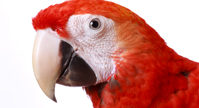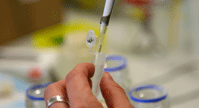Canine Color Index
Canine Color Charts
A-Locus (Fawn, Sable, Black-and-Tan/Tricolor, Recessive Black)
This chart explains what a dog's phenotype will be based on his genotype. This chart assumes the dog is "n/n" for the K-Locus. Adding in one or more copies of the KB-allele will modify the pigment that is being produced.
| Coat Color | Genotype |
|---|---|
| Sable | Ay,Ay |
| Sable (Black-and-Tan/Tricolor hidden) | Ay,at |
| Black-and-Tan/Tricolor | at,at |
| Solid Black/Bicolor | a,a |
| Sable (Solid Black/Bicolor hidden) | Ay,a |
| Black-and-Tan/Tricolor (Solid Black/Bicolor hidden) | at,a |
B-Locus (Brown, Chocolate, Liver)
The black (B) allele is dominant to the brown (bs, bd, bc) alleles. In this gene are 3 common mutations (bs, bd, bc) which result in brown instead of black eumelanin production. In some breeds, such as the French Bulldog, additional mutations not identified may affect eumelanin production. Below are the known "b" alleles in different breeds of dogs. Please note that there is no difference between these alleles in the coloration of a dog; for example, a dog that is bsbs will not appear different than a dog that is bdbd or bcbc.
| Breed | Breed color | Possible Alleles Present |
|---|---|---|
| Australian Shepherd | Red | bs, bd |
| Border Collie | Brown | bs, bd, bc |
| Chesapeake Bay Retriever | Brown, Sedge, Deadgrass | bs, bc |
| Chinese Shar-Pei | Chocolate, Lilac | bs, bc |
| Cocker Spaniel | Brown, Liver | bs, bd, bc |
| Dachshund | Chocolate | bs, bd |
| Dalmatian | Liver | bs, bd, bc |
| Doberman Pinscher | Red | bd |
| English Setter | Liver Belton | bs |
| English Springer Spaniel | Liver | bs, bd |
| English Pointer | Liver | bs, bd |
| Field Spaniel | Liver | bs, bd, bc |
| Flatcoated Retriever | Liver | bs, bd |
| French Brittany Spaniel | Liver | bs, bd |
| German Shorthaired Pointer | Liver | bs, bd, bc |
| German Longhaired Pointer | Liver | bs, bd, bc |
| German Wirehaired Pointer | Liver | bs, bd, bc |
| Italian Greyhound | Isabella, Chocolate | bc |
| Labrador Retriever | Chocolate | bs, bd, bc |
| Large Munsterlander | Brown | bs, bd, bc |
| Newfoundland | Brown | bs, bd, bc |
| Poodle | Brown, Cafe-au-lait | bs, bd, bc |
| Portuguese Water Dog | Brown | bs, bd |
| Pudelpointer | Liver | bs, bd, bc |
| Small Munsterlander | Brown | bs, bc |
| Weimaraner | Mouse-gray | bs, bd, bc |
D Locus and B Locus
This chart explains the phenotype or appearance of a dog based on the genotype. In this case, the term "basic color" refers to areas that are self-colored, and would be black without any additional modifiers such as the chocolate and dilute loci. For dogs that are fawn or sable, it should taken into account that this may only refer to the nose and foot pads of the dog.
Dogs that are "ee" will only express yellow pigment, so this table holds true for all dogs of that genotype, regardless of the A- and K- loci.
| Chocolate | Dilute | Basic Color |
|---|---|---|
| B/B | D/D | Black |
| B/B | d/d | Blue |
| b/b | D/D | Liver/Chocolate |
| b/b | d/d | Faded Liver/Lilac |
| e/e | D/D | Yellow |
| e/e | d/d | Champagne |
E-Locus (Recessive Yellow) and B-Locus
This chart explains the phenotype or appearance of a dog based on the genotype of the dog for "self-colored" areas of a dog. This refers to areas of a dog that would be black without other modifications (ie a solid Labrador Retriever, or the black part of a black-and-tan dog). It does not affect areas that are colored otherwise, such as fawn or sable.
Dogs that are "ee" will only express yellow pigment, so this table holds true for all dogs of that genotype, regardless of the A- and K- loci.
| B-Locus | E-Locus | Basic Color |
|---|---|---|
| B/B | E/E | Black |
| B/B | E/e | Black carrying yellow |
| B/B | e/e | Yellow |
| B/b | E/E | Black carrying brown |
| B/b | E/e | Black carrying brown and yellow |
| B/b | e/e | Yellow carrying brown |
| b/b | E/E | Brown |
| b/b | E/e | Brown carrying yellow |
| b/b | e/e | Yellow with a brown nose |
(S Locus) Parti, Piebald, or Random White Spotting
There is no single basis for white spotted patterns that occur in animals like cats, dogs and horses. In horses random white spotting, or deletion of color, has been determined to be caused by more than half a dozen known genetic factors. In more than 25 different dog breeds, a mutation found in a gene called
Microphthalmia Associated Transcription Factor- (MITF) is associated with a piebald spotting. In many breeds piebald behaves as a dosage-dependent trait. This means that dogs with a single copy (Sn) of the MITF variant will express a limited white spotting pattern, while dogs that have 2 copies (SS) of the variant will exhibit more white with very little color. In some breeds dogs that are (SS) are completely white while dogs that are (Sn) have what is referred to as mantle.
| Breed | Breed Color | |
|---|---|---|
| Basset Hound | Parti | |
| Beagle | Parti | |
| Border Collie | Piebald | |
| Boxer | White or Flash | |
| Bulldog - English | Piebald | |
| Bulldog - French | Piebald | |
| Cavalier King Charles Spaniel | White | |
| Chihuahua | Piebald | |
| Chinese Shar-Pei | Flowered | |
| Cocker Spaniel - America | Parti | |
| Cocker Spaniel - English | Parti | |
| German Shepard | Piebald | |
| Dachshund Longhaired | Piebald | |
| Dachshund Smooth | Piebald | |
| Dachshund Wirehaired | Piebald | |
| French Brittany Spaniel | Parti | |
| German Shorthaired Pointer | and White | |
| German Longhaired Pointer | and White | |
| German Wirehaired Pointer | and White | |
| Goldendoodle | Parti | |
| Havana Silk | Parti | |
| Havanese | Parti | |
| Labradoodle | Parti | |
| Newfoundland | Landseer | |
| Pointer | and White | |
| Poodle | Parti | |
| Portuguese water dog | Parti | |
| Shar Pei | Flowered | |
| Saint Bernard | Piebald | |
| Whippet | Spotted | |
| Yorkshire Terrier | Parti |
Submit a Sample For Testing:
To submit a sample for testing please go to Canine Test Now.
To order a sample collection kit please go to Order Sample Collection Kits.










